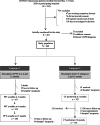Lung function and radiological findings 1 year after COVID-19: a prospective follow-up
- PMID: 36096801
- PMCID: PMC9466319
- DOI: 10.1186/s12931-022-02166-8
Lung function and radiological findings 1 year after COVID-19: a prospective follow-up
Abstract
Background: The coronavirus disease (COVID-19) pandemic has already affected more than 400 million people, with increasing numbers of survivors. These data indicate that a myriad of people may be affected by pulmonary sequelae of the infection. The aim of this study was to evaluate pulmonary sequelae in patients with bilateral COVID-19 pneumonia according to severity 1 year after hospital discharge.
Methods: COVID-FIBROTIC is a multicenter prospective observational cohort study for admitted patients with bilateral COVID-19 pneumonia. Pulmonary functional outcomes and chest computed tomography sequelae were analyzed 12 months after hospital discharge and we classified patients into three groups according to severity. A post hoc analysis model was designed to establish how functional test changed between groups and over time. A multivariable logistic regression model was created to study prognostic factors for lung diffusion impairment and radiological fibrotic-like changes at 12 months.
Results: Among 488 hospitalized patients with COVID-19 pneumonia, 284 patients had completed the entire evaluation at 12 months. Median age was 60.5 ± 11.9 and 55.3% were men. We found between-group differences in male sex, length of hospital stay, radiological involvement and inflammatory laboratory parameters. The functional evaluation of pulmonary sequelae showed that severe patients had statistically worse levels of lung diffusion at 2 months but no between group differences were found in subsequent controls. At 12-month follow up, however, we found impaired lung diffusion in 39.8% unrelated to severity. Radiological fibrotic-like changes at 12 months were reported in 22.7% of patients (102/448), only associated with radiological involvement at admission (OR: 1.55, 95% CI 1.06-2.38; p = 0.02) and LDH (OR: 0.99, 95% CI 0.98-0.99; p = 0.046).
Conclusion: Our data suggest that a significant percentage of individuals would develop pulmonary sequelae after COVID 19 pneumonia, regardless of severity of the acute process. Trial registration clinicaltrials.gov NCT04409275 (June 1, 2020).
Keywords: COVID 19; Lung fibrosis; Pulmonary sequelae.
© 2022. The Author(s).
Conflict of interest statement
The authors declare that they have no competing interests.
Figures


References
-
- WHO. WHO coronavirus (COVID19) dashboard. 2022. www.covid19.who.int. Accessed 4 Mar 2022.

